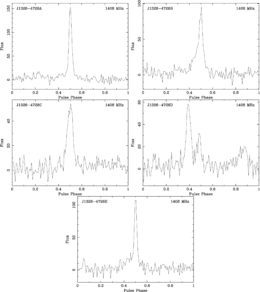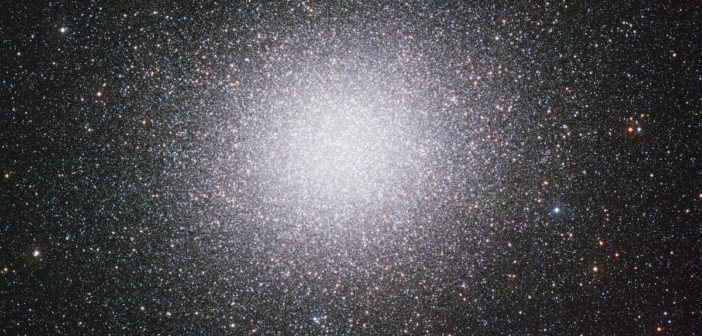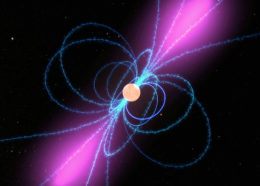The globular cluster Omega Centauri makes for an impressive sight — millions of stars gravitationally bound into a beautiful sphere, its core alight from the glow of densely packed bodies. A recent study has unveiled a new discovery at the heart of this cluster: five long-anticipated pulsars.
What Lies At the Core

Image of two globular clusters (can you spot them? Look carefully!) in the Milky Way. Omega Centauri is brighter and more massive than either of these — or any other Milky Way globular cluster. [ESO/D. Minniti/VVV Team]
Omega Centauri’s large mass and unusual formation history open two interesting possibilities:
- The cluster might contain massive black holes.
Theory predicts that the conditions at the center of massive stellar clusters are ripe for collisions that drive the growth of intermediate-mass black holes with perhaps hundreds to tens of thousands of solar masses. - The cluster core might show evidence of dark matter annihilation.
If Omega Centauri was once a dark-matter-dominated dwarf galaxy, then its relatively close distance makes it an excellent target to search for dark matter annihilating at its center.
Pulsars as Probes
How can we explore these possibilities? Our best bet would be to study the motions and signatures of radio pulsars — rapidly rotating, magnetized neutron stars — in the cluster’s core. The motions of these dense objects would provide information about the core’s dynamics, potentially revealing the gravitational influence of lurking massive black holes. The signatures of the pulsars’ emission could also tell us about the interstellar medium of the cluster, constraining particle dark matter annihilation models.
But though radio pulsars are common in the cores of other globular clusters, they’ve remained elusive in Omega Centauri. A tantalizing hint came in 2010 with the discovery of a gamma-ray source in the cluster’s core — but years of searching for pulsed radio emission from this location turned up nothing.
A Population Found

The pulse profiles of the five newly discovered millisecond radio pulsars in Omega Centauri’s core. Click to enlarge. [Dai et al. 2020]
These newly discovered pulsars have spin periods that range from 4.1 to 6.8 milliseconds. While four of them are isolated objects, the fifth lies in an eclipsing binary system with a very low-mass star, orbiting once every 2.1 hours.
These pulsars may just be the tip of the iceberg: Dai and collaborators found additional compact sources in deep radio continuum images of Omega Centauri’s center, suggesting there may be more pulsars awaiting discovery. In the meantime, tracking the five pulsars now known will give us an excellent opportunity to probe the properties of this massive, bright cluster and learn more about its secrets.
Citation
“Discovery of Millisecond Pulsars in the Globular Cluster Omega Centauri,” Shi Dai et al 2020 ApJL 888 L18. doi:10.3847/2041-8213/ab621a


5 Comments
Pingback: From AAS NOVA: “A Pulsed Discovery In Omega Centauri” | sciencesprings
Pingback: Un descubrimiento pulsante en Omega Centauri – Observatori Astronòmic
Pingback: Febrero 2020 – Observatori Astronòmic
Pingback: Un descubrimiento pulsante en Omega Centauri « SEDA / LIADA - RedLIADA - Cursos LIADA - Cielo del Mes - Fenómenos Astronómicos - RELEA
Pingback: Un descubrimiento pulsante en Omega Centauri « Sección de Astrofísica de la LIADA